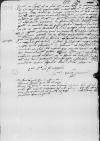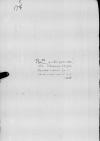Letter #2136
Ioannes DANTISCUS to Tiedemann GIESEHeilsberg (Lidzbark Warmiński), 1539-04-25
English register:
Upon returning from Seeburg (Zybork) the previous day, Dantiscus found a messenger with a letter from the Duke [Albrecht I von Hohenzollern-Ansbach]. At the Duke’s request, he is passing on the letter for Giese to read. In his reply he has assured the Duke that the [Royal Prussian] Council will make an effort to ensure the Diet [of Royal Prussia] deals with the matters outlined in the letter.
Dantiscus has nothing against Giese writing [to the Duke] whatever he sees fit, but he thinks that in the face of direct danger they can only count on God’s help, and not advice and help from outside.
Dantiscus has asked the Elbing (Elbląg) Town Council and the Gdańsk (Danzig) Town Council to inform the interested parties about the moving of the Diet. He promises to send news as soon as his messenger returns from the court.
In the postscript Dantiscus apologises for placing his signature at the bottom of the letter too high up, but he thinks Giese will not hold it against him, since he does that sometimes too. He assures Giese of the constancy of his friendship towards him.
Manuscript sources:
Auxiliary sources:
Prints:
| ||||||||||||||
Text & apparatus & commentary Plain text Text & commentary Text & apparatus Excerpts concerning Dantiscus' travels
Reverendissimo in Christo Patri Domino, domino
Reverendissime in Christo Pater et Domine, frater et amice carissime et honorande.
Salutem ex animo pristinamque incolumitatem a Domino Deo Dominationi Vestrae Reverendissimae intime precor.
1539-04-24⌊Heri1539-04-24⌋ rediens ex
Ceterum, quemadmodum nuper attigi, cf.
Cui iterum atque iterum prosperam summopere opto valetudinem.
Ex
Reverendissimae Dominationis Vestrae frater integerrimus
Postscript:
Debueram me paulo inferius, ut consuevi, subscribere, quod certe mihi exciderat, non tamen Dominationem Vestram Reverendissimam aegre laturam existimo, cum ad eum modum ipsa eiusmodi subscriptione subinde utatur. Hoc igitur adnotavi, ne putet ob id quicquam ex coeptae inter nos amicitiae observantia decessisse etc.[2]
[1 ] Dantiscus uses the past tense here in regard to his letter to
[2 ] At the time the issue of where to place the subscription in the letter was discussed by Joan Luis Vives in his treatise cf. Juan Luis Vives, De conscribendis epistolis : critical edition with introduction, translation, and annotation, ed. by Charles Fantazzi, Brill, 1989, series: Selected Works of Juan Luis Vives 3 , p. 70⌊De conscribendis epistoliscf. Juan Luis Vives, De conscribendis epistolis : critical edition with introduction, translation, and annotation, ed. by Charles Fantazzi, Brill, 1989, series: Selected Works of Juan Luis Vives 3 , p. 70⌋

